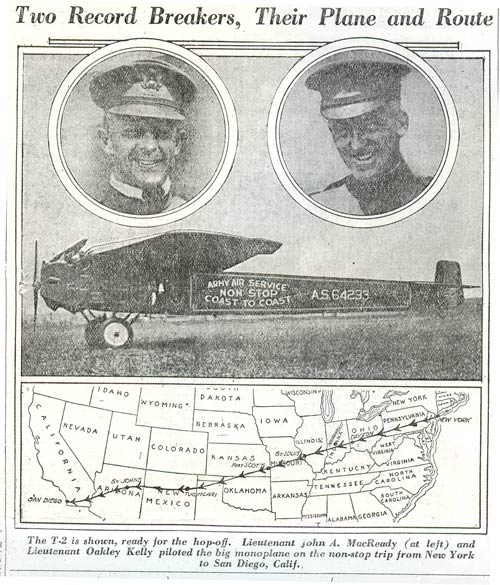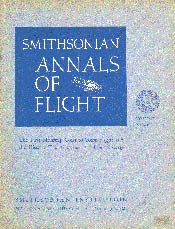| OAKLEY
G. KELLY landed twice at the Davis-Monthan Airfield. Both flights,
on January 14, 1928 and November 6, 1931, were solo and both
appeared to be routine cross-country excursions in military
aircraft. His rank was lieutenant. He is most known for an earlier
cross-country flight made with fellow officer, John
A. Macready.
Their adventure follows.
FAMOUS FOR 15 MINUTES
As reviewed in the NY Herald-Tribune for Friday May 4, 1923,
Oakley Kelly is best known for his transcontinental airplane
flight on Wednesday May 2, 1923, when he and John A. Macready
flew a single-engine, high wing Army Fokker T-2 over the 2,625
miles from Mitchel Field, NY to San
Diego, CA in 26 hours
50 minutes and 48 seconds. This set the record for transcontinental
flight by a heavier than air craft. Their airplane was not
refueled enroute. An image and additional information about Fokker 64233 is at the NASM Web site. The photo, below, is from the May 4th article.
Kelly is on the right.
 |
The media heralded their flight as a harbinger of new commercial
and military advantages. From the military perspective, the
Herald-Tribune reports, “…a non-stop transcontinental
air voyage indicates the feasibility of transporting men,
messages, equipment or any other vital necessity from one
coast to the other in an incredibly short space of time.”
And, “Another feature regarded of secondary importance
is the demonstration that it is possible to concentrate large
numbers of airplanes at any desired point within the United
States on short notice.”
From the commercial perspective, “…the accomplishment
of the two pilots is expected to encourage aircraft companies
to organize aerial transport services and establish an increased
number of landing fields and air routes over the country.”
The Herald-Tribune article described the takeoff from NY
as a dangerous one for the pilots, due to the 780 gallons
of fuel carried, as well as 32 gallons of oil and 25 gallons
of water. Their aircraft was 49 feet long with a wingspread
of 74 feet, 10 inches. It was equipped with a Liberty engine,
which the pilots operated at an impressive 90% power the entire
way.
Their flight, which began at 12:36:53 on May 2nd, was made
without weather reports, flying instruments, radio or parachutes.
The airplane was so heavy they were forced early in the flight
to fly just above the ground and below clouds, through rain,
storms and night.
FAINT PRAISE
Upon landing at Rockwell Field, Riverside, CA, Rockwell Commandant, and Register pilot,
Major Henry “Hap”
Arnold endured the crush of spectators to greet the pilots.
He said, “Congratulations! It was a marvelous flight
and we are surely proud of you.”
General Pershing wired, “We have been following you
with great interest. The army is proud of your wonderful achievement.
Please accept my official and personal greetings and congratulations.”
Major General Patrick, Chief of the Army Air Service, telegraphed,
“I extend to you most hearty congratulations upon your
successful completion of world’s record, non-stop flight
from New York to San Diego. This flight is viewed with pride
by all Air Service officers, and brings to this country increased
prestige in the world of aeronautics. It is the fruit of a
determined and courageous effort of which you may both be
justly proud.”
President Harding telegraphed a sentence with five (count
them) hyphens, “Accept my most cordial congratulations
on the success of your record-making, non-stop, coast-to-coast
flight, successfully completed to-day. You have written a
new chapter in the triumphs of American aviation.”
UNEXPECTED, AND UNDESERVED, CONSEQUENCES
Now comes an article in the Los Angeles Times of May 21,
1923. “The United States is shamefully lacking in extending
recognition to its national defenders who perform some valorous
deed or distinguished service for their country, according
to Secretary of War Weeks.
“The War Secretary’s apology for such humiliating
but unavoidable conduct of the nation’s leaders was
voiced in an address to his party of Senators and Congressmen
and to Army aviators at…Rockwell Field today. It was
his reply to an appeal for governmental recognition of the
historic nonstop flight…by Lieuts. Kelly and Macready.
“…Kelly and Macready … must content themselves
with remaining as first lieutenants. They will receive no
promotion to captaincies or any other ranks for their record
flight. They will receive no increase in pay or any compensation
for helping to boost their country to the forefront of all
air forces in the world. They will receive no medals. Such
was the verdict they heard from the Secretary of War as they
sat silently across the luncheon table from the highest official
in the United States Army.”
Oakley Kelly, December 26, 1924
 |
Overlooking this lapse, in a broader sense, even though it was unrefueled, their
flight was the forerunner of later, longer (in time and distance)
flights with air-to-air refueling that were made in the later
1920's and 30's. The most significant military example might
be the 7-day flight made by the "Question
Mark", another Fokker aircraft that visited Tucson,
with its crew (including Carl Spatz, Elwood Quesada and Ira Eaker) just days before setting its record.
Likewise, their flight stood on the shoulders of lessons learned from the "Round-the-Rim" flight led by Register pilot E.E. Harmon. Harmon and his crew flew the circumference of the U.S. national borders in a Martin bomber just a few years earlier during 1919.
A short time after the transcontinental flight, Kelly appeared in the papers again December 26, 1924, at left, from the Oakland Tribune. We should be pleased that this paper exhibits a formal portrait including his wife.
Kelly and a passenger were flying from Vancouver, WA to San Francisco, CA, Crissy Field when they made a precautionary landing at Marysville, CA because of darkness. Their landing was unscheduled and unannounced, thereby causing some concern by the Army. A search was begun as soon as they became "overdue". Note that the fillers from the other reporting stations were a little behind in their "news".
Interestingly, another "filler" at the bottom of this same newspaper announced the death of the engineer who sailed on the Monitor during its battle with the Merrimac.
Oakley Kelly retired from military service as a Colonel on
March 31, 1948. He died at age 74 in San Diego, CA.
---o0o---
Dossier 2.2.43
THIS PAGE UPLOADED: 12/17/05 REVISED: 10/12/07, 02/02/09, 05/04/10
As of May 4, 2010, this page is Google rank #1 for a search on "Oakley G. Kelly."
|




